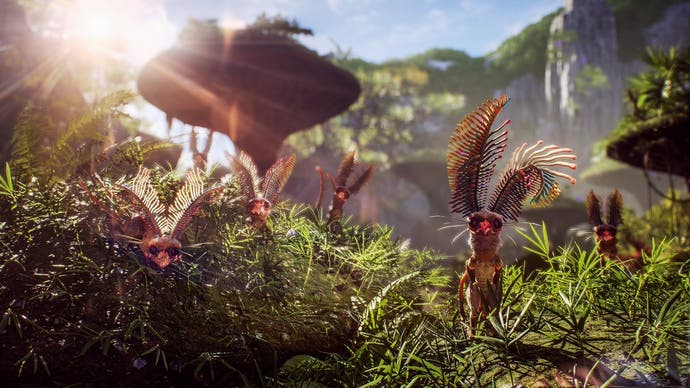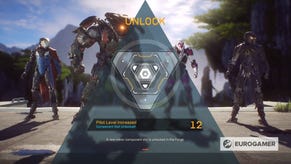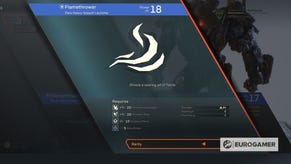Searching for BioWare, somewhere in Anthem's Fort Tarsis
Grabbit and don't let go.
BioWare has been asked - a lot - why it is the studio to make Anthem, a game far removed from its traditional single-player role-playing game fare. BioWare's responses have been - 'well, we've done multiplayer before', 'we've experimented in other genres before', and also 'would you please let us make something new for a change?' And fair enough. But from day one, many BioWare fans have been turned off by the idea of a game not specifically built for them. (And I'm sorry BioWare, as much as you protest 1996's Shattered Steel had multiplayer too, single-player RPGs are the million-selling corner of the market you have pretty successfully endeared yourself to.)
Yet a huge chunk of Anthem has been built specifically for BioWare fans - a chunk which is rigidly single-player, follows close to the studio's recent formula, and where BioWare's loremasters have been crafting characters and story which feel very familiar to the ones fans have previously fallen in love with. This portion of the game, Fort Tarsis, is a classic BioWare hub. And, for whatever reason, BioWare has barely mentioned any of it.
Anthem is being sold on its team-based shooting, its loot game and its shiny mech suits, but the part of Anthem I've found myself enjoying is the stuff you do when all of this goes away. When I step out of my mech suit, onto Fort Tarsis' cracked cobbles and through its Moroccan arches, across its bleached plazas, down stairways flanked by uneven stones, into its dark undercrofts. Here you'll find Anthem's quest givers and random NPCs, lore tabs and collectibles. Here you'll find a warmth, humour and depth not found anywhere outside its walls.

Anthem's population, weird and colourful, are lounging and leaning, waiting for you to pass the time. Amongst your regular contacts are passers-by, there to share a story if you'll listen, of their place in the world and how they're surviving in it. BioWare has never spoonfed its lore but presented a banquet of it, the strength of your appetite the only blocker to how many of its sci-fi sounding words you care to understand. Cypher. Corvus. Urgoth. And where Mass Effect has space hamsters and Dragon Age has nugs, Anthem has grabbits.
Any time you return from a mission you'll find conversations highlighted on your map ready to begin. Quest givers like Haluk and Tassyn slowly open up to you over time, warming in a way which reminds me of Dragon Age's Cassandra. Side characters like Jani and Kismet are the start of Anthem's wider story outside the game in spin-off media. Others fill in backstory on the world's history, geography, culture - or just remind you there are some unusual people around.
Neeson Giles is a creep, but I can't help talk to him every time I hear him chattering away nearby. He's a gossip, and typically if you've just gotten closer to one of your main allies, he'll have heard something poisonous about them he can't wait to share instead. His job is to do the fort's laundry, and he's bitter about it. Pirndel Blatch, meanwhile, is the fort's custodian but spends his time moaning about health and safety. He's the Facebook friend who would love some more support with their petitions.

A section of Anthem's children's book Tessi the Tesilar"It's not that, Grabbit. It's just that I feel on edge, and when I fall off it, I don't want to land on you."
"Don't be silly, Tessi," Grabbit scolded. "Everyone knows that when you're on edge, friends are the best parachute."
Wander the fort's passageways and you'll find scrolls to read or radios broadcasting the game's versions of children's stories and pulpy romance. Every mission, every character, every gun has a log page, kept constantly updated as more about each is uncovered. Navigate Anthem's labyrinthine UI further and you'll belatedly uncover you have a fictional email inbox (finding this has never once been prompted to me) with its own spam section. It's a pretty funny read.
To be clear, there are no characters here with the diverse backgrounds of Mass Effect's many alien species, or Dragon Age's fantastical races. And your choices with them are limited - you colour their stories through smaller binary dialogue choices, rather than make big life or death decisions. But in Anthem's weird world, some of these more intimate, more mundane choices stand out - encouraging people to not give up hope, to maybe try sobering up, and that yes you will sign that petition, I suppose.
It's hard to know how much BioWare fans will hear about this part of the game, and how it has been built for them to explore. Certainly, there's been plenty to talk about in early impressions and reviews about the main Anthem gameplay loop and how successful BioWare has been at nailing that. But I'd encourage BioWare fans to try Anthem someday for its Fort Tarsis stuff. There's half a BioWare game here they'd like, if they know to look.

















